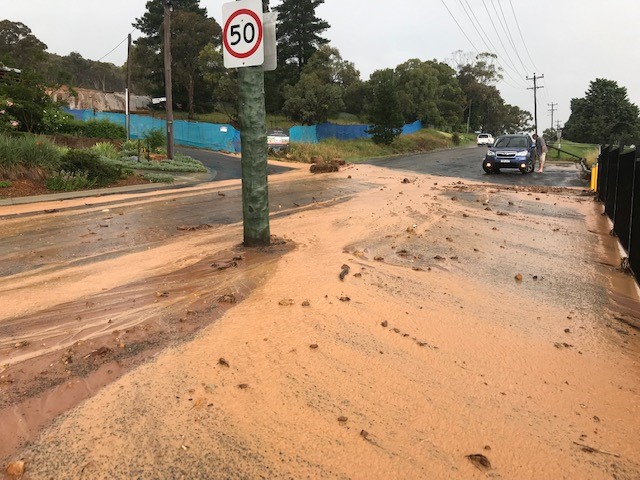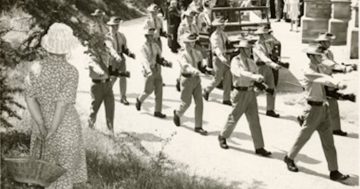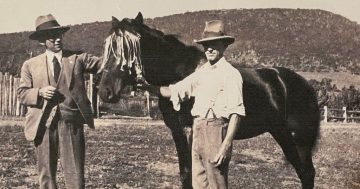
Heather West inspects damage from erosion near the Wetlands viewing platform. Photo: Friends and Residents of Goulburn Swamplands.
An environmentalist has lashed out at the long-term management of Rocky Hill, one of Goulburn’s most valuable natural assets.
In the latest setback following clearing to make way for houses, months of rain has washed out a scar on the hill, filled backyards and the Goulburn Wetlands below with mud and gravel, and likely killed fish and reptiles.
One of the wetlands original driving forces, Rodney Falconer, a former Goulburn high school teacher and environmental consultant, says Rocky Hill is an important scenic backdrop for the city, easily seen and complementing Goulburn’s wonderful heritage architecture. Mr Falconer says the residential development will create yet another hillside of ‘ticky-tacky’ houses.
Heather West from the Friends and Residents of Goulburn Swamplands (FROGS) said land clearing on the hill, contrary to Mr Falconer’s recommendations years ago, sent mud flowing into May Street backyards. At the wetlands, gravel had washed over grassed areas, mud was dumped into the ponds, slopes were eroded and revegetation mulching work gutted.
Mrs West said two of the dams the developers had since built on the cleared site had breached in the last downpour.
“Unfortunately, when it isn’t raining, they pump out the dams and let the water flow down May Street into the stormwater drains and into the Wetland ponds,” Mrs West said.
The Goulburn Group, which initiated the wetlands project, says hundreds of tonnes of mud have destroyed paths and vegetation and caused significant pollution to the water, with the likely deaths of many fish, reptiles and other species.
The Goulburn Group says the deluge was an environmental disaster waiting to happen given the indiscriminate clearing of trees and other vegetation on a steep hill.
“We are dismayed that, despite objections and warnings on multiple occasions, inadequate action was taken to prevent what has occurred,” a spokesman said.
A Goulburn Mulwaree Council spokesman said the developer, Lockenstrand Pty Ltd, has been fined twice for working outside consent guidelines and polluting water.
A stop-work order was issued and the only work allowed were control and prevention measures.
The spokesman said the developer was not allowed to pump silt water out of the dams during fine weather and needed to let sediment settle as they were only allowed to pump clean water out.

May Street, Goulburn, after the recent storm. Photo: FROGS.
“Any dirty water that leaves the site is an offence and is considered a pollution incident,” he said. “Council is currently assessing our legal options in regard to further action against this developer on this matter.”
Region Media has sought comment from the developer.
For several years, Mr Falconer has provided vegetation reports and recommendations for Rocky Hill. He cites author Jim Smith’s Aborigines of the Goulburn district which records the Indigenous Gandangara who had a large corroboree ground, featuring large rocks on top of Rocky Hill where the memorial stands today. Below those rocks was a boy’s initiation ground.
Pleas from author Mary Gilmore, who lived nearby, to leave the Aboriginal areas of cultural significance intact were ignored as the community built the war memorial.
Large areas of the hill were wheelbarrowed up to make the war memorial and vegetation was stripped. The original eucalypt forest didn’t grow back. Instead, Tasmanian and South Coast eucalypts spread from nearby street trees onto the northern edge.
At the southern edge of Rocky Hill stood ancient scribbly gum with a healthy under-storey in which mostly Grevillea arenaria grew, which protected insects and small birds. This area was part of a significant migration route for native animals from the South Coast to the tablelands. The southern edge could still harbour the Rosenberg monitor, a threatened goanna species.
Yellow box woodlands, another threatened ecological community, grew at the bottom of the hill.
“I’m not sure how that was let go, certainly the environmental protection laws didn’t do it any favours,” Mr Falconer said.
He had also learned from land authorities water poured from rocks on the hillside long after periods of heavy rain.
“Any houses dug in there, disturbing the rock, could put them at risk and possible landslides and so on,” he said.
“That whole central part of Rocky Hill was important, botanically diverse and had a lot of large old scribbly gum. It was in fairly good condition and a major asset to the town, but not viewed so by some of the older councillors in particular,” he said, referring to the former Goulburn City Council.
He said the council had failed then and still today to appreciate Rocky Hill as an environmental and aesthetic asset.
“The management of this site has not been studiously policed whatsoever,” Mr Falconer said.
Original Article published by John Thistleton on Riotact.












